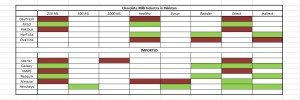In 2012, Pakistan was producing over 20 billion liters of tradable white milk per year, making it the 3rd largest producer in the world. In 2013, Nestle issued a press release claiming a production capacity of half a billion liters of milk. It is estimated that Pakistan fails to meet local demand by up to five billion liters. So its not surprising that the promise the industry and its returns attracts business families. We spoke to Suleman Monnoo of the Akhtar Group regarding the decision to enter the high demand market, their USP and more recent endeavor to break into flavored milk.
I’ve heard shoppers say “Bonus wala Surf dedein” and ask “Powder wala Milk Pak hai?”, so we can assume that there exist established players in multiple high frequency CPG categories. How does a textile family gain interested to compete in the most cut throat one?
Anyone with the capital backing is after this space and yes, there are some established players in the mindsets of the masses. So education was our largest concern, as was ensuring product quality at a level that addresses the concerns of our rising educated audiences.
In 2008 we faced a crisis in the textile industry and to counter this, everyone was trying to diversify. At the time, Pakistan was the fifth largest producer of dairy in the world. After reading “I Too Had a Dream” by Dr. Verghese Kurie, my interest in the area was fueled. I learned that New Delhi’s sales as a city are equivalent to our entire country. We studied the category and found it advantageous to become the first in Sindh to enter dairy. Punjab has had it easy because of the processors in place, the drawback for us was the minimum requirement in volumes need to afford the required processors, which when unmet, can result in the product going bad. Our research reflects that 80% of consumption is loose milk. To avoid these issues, we set out to have our own farm.
The kind of infrastructure you’re referring to drives up costs. How did you mitigate this against the existing investment needed?
If market visits to India taught me anything, its that no MNC could beat me if I had the vision, because MNC’s have too many overheads coming with growth. At the moment, Nestle has collection centers in the radius of villages like Sahiwal. Along with Engo and Haleeb, they utilize a contractor system and the incentives rotten the game. So when the demand goes up and the contractor cannot meet it, the product is fabricated with fake shipments.
While studying MBA from IBA, I learned about corporate farming abroad, wherein the incentive’s for fraud is less and contractors are incentivized to provide the right product at the ethical volumes they can create. Demand is therefore generated based on these volumes instead of the other way around. This is evidently not the case here because we are currently the third largest creator and consumer of dairy in the world. The high frequency of consumption encouraged in the demand generation process creates an unnecessary strain on the contractor.
You’re not only competing with large players, but pre-purchased shelf space, a product that lasts longer than yours and an acquired taste to buffalo milk. What was your unique counter?
In this industry, raw material is a game changer. And yes, the local pallet is developed on buffalo milk instead of cow milk. But the cow is more economical and it’s milk is better for digestion. A buffalo eats more and produces less. A business family like ours thinks long term, invests in assets that are longer lasting and efficient. We imported cows from Australia because the local variety are hard to certify as legitimate. We brought in an expatriate farm manager and the corporate farming system (similar to Almarai) to ensure quality assurance and meeting of standards practiced in developed nations. Taimur Butt, the master franchiser of Red Mango, recently visited one of our farms and gained international clearance to use our products to create the his acclaimed frozen yogurt products.
Unbranded milk accounts for three quarters of the current market, so why invest so much in branding when the market is so fixated on tried & tested favorites?
That’s short term thinking and a middle class approach. A brand is a life line, its like a child. We invest in our children and eventually they in turn support us. It’s the same with DayFresh and the overall brand experience. My experience in textile has taught me that if you have the right product and can communicate it, you can sell anything. We also learned (the hard way) to play with price perceptions. Five years ago, milk was PKR 50 per liter; we priced ours at PKR 45 per liter and it backfired because consumers new to our brand considered this to be reflection of quality. Total plate counts (TPC) is the industry standard for measuring milk quality. When it exceeds 100k, it becomes unfit for long term human growth and consumption’s. At the expense of shelf life (one week), our product has a 50k while our competitors measure in the millions. For the retailer, low shelf life is a problem, so we have our own distribution centers and network as well. Luckily, trade level education campaigns have improved the adoption, and the name DayFresh, reflects the brand promise.
You’ve been in business eight years to date. What were your key challenges, and what do you think is driving the sustainability and adoption?
Like I said, a good product that is communicated well, will sell. We have the right raw material, are small enough to focus and deliver on promising. We are also small enough to respond to consumer needs and its very important in a product like milk. After being exposed to open air, milk goes bad pretty fast. So we pump our cows with automation and chill the milk to 4 degree Celsius to stall further bacterial growth. This commitment to high quality limits to shelf life, and its adoption by retailers is a challenge so we need to invest more in attaining touch point shelf space and our own distribution network.
Based on advertising messaging, we can safely postulate that flavored milk is aimed at children. A glance at local or international trade further shows that international players in the direct and indirect nutrition positioning dominate shelf space. Canteens at major schools and colleges have been branded with some of these for years. So what was the rationale behind entering flavored milk?
We think Pakola has done the best job in this category because they are exclusively focused on flavored milk and research points this to be a small category, expected to reach 20 billion liters in demand this year alone. We sought it out due to our increasing capacity and interest to tap new markets backed by retained earnings from DayFresh. The only downside is that the market is not that developed, and when you’re leading the charge, you’re also incurring costs.
While children are the end consumers, their parents – health conscious and concerned for long term health & safety – can be influenced by our campaigns. We are a trusted brand, so when we launch flavored milk backed with the same high quality infrastructure, parents trust us. Insights from our own delivery network indicate that our products are consumed as a key breakfast item, and chocolate or strawberry milk is more appealing to children than the plain alternative.
Thank you for your time Suleman, it was a pleasure.



